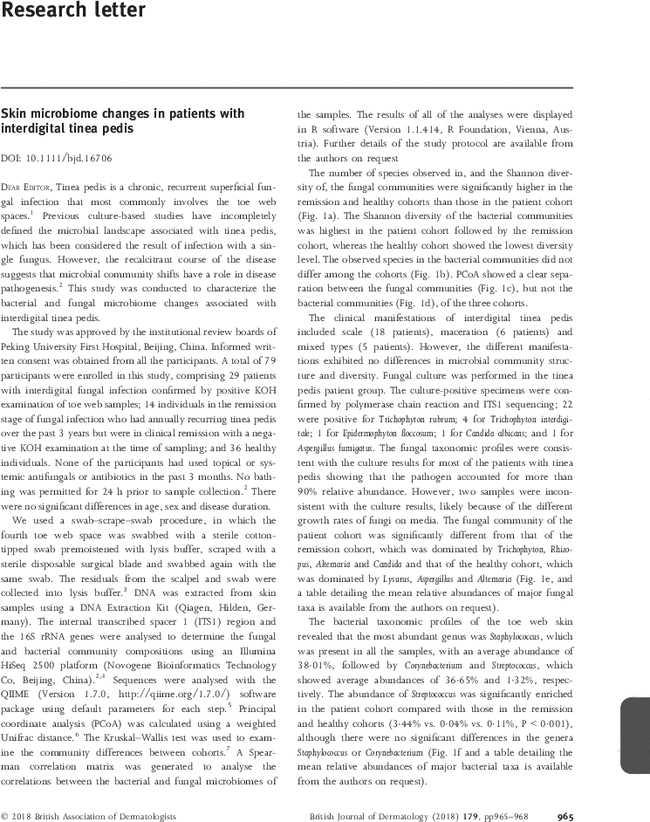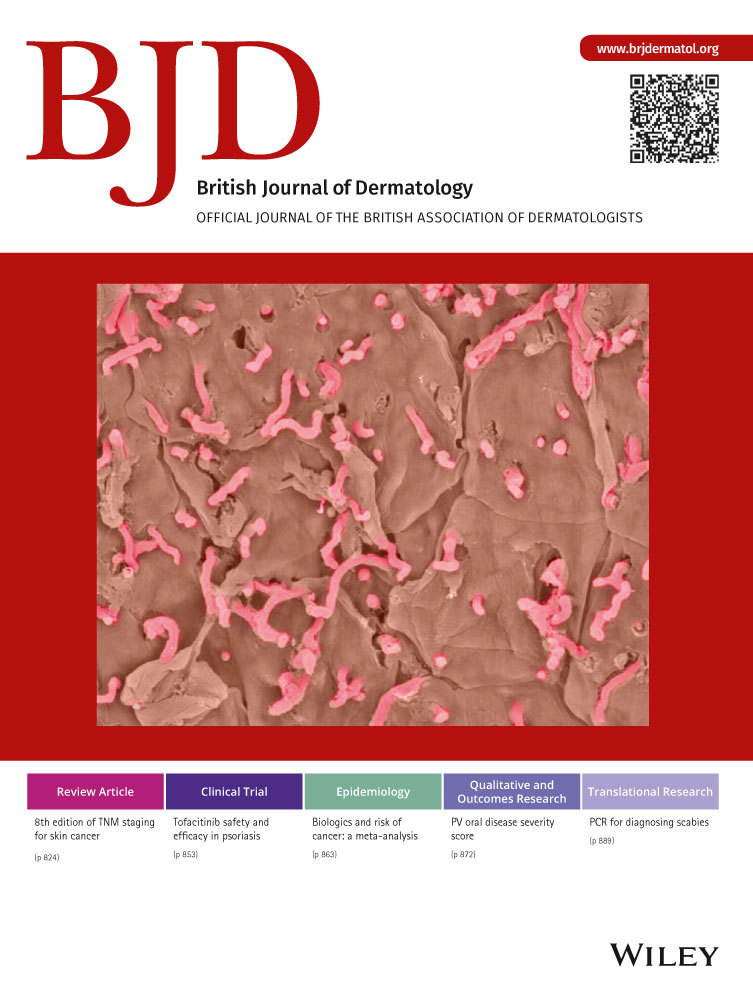Skin microbiome changes in patients with interdigital tinea pedis
R. Wang
Department of Dermatology, Peking University First Hospital, Beijing, China
Beijing Key Laboratory of Molecular Diagnosis of Dermatoses, Beijing, China
Research Center for Medical Mycology, Peking University, Beijing, China
Search for more papers by this authorY. Song
Department of Dermatology, Peking University First Hospital, Beijing, China
Beijing Key Laboratory of Molecular Diagnosis of Dermatoses, Beijing, China
Research Center for Medical Mycology, Peking University, Beijing, China
Search for more papers by this authorM. Du
Peking University Institute of Systems Biomedicine, Beijing, China
Search for more papers by this authorE. Yang
Peking University Institute of Systems Biomedicine, Beijing, China
Search for more papers by this authorJ. Yu
Department of Dermatology, Peking University First Hospital, Beijing, China
Beijing Key Laboratory of Molecular Diagnosis of Dermatoses, Beijing, China
Research Center for Medical Mycology, Peking University, Beijing, China
Search for more papers by this authorZ. Wan
Department of Dermatology, Peking University First Hospital, Beijing, China
Beijing Key Laboratory of Molecular Diagnosis of Dermatoses, Beijing, China
Research Center for Medical Mycology, Peking University, Beijing, China
Search for more papers by this authorCorresponding Author
R. Li
Department of Dermatology, Peking University First Hospital, Beijing, China
Beijing Key Laboratory of Molecular Diagnosis of Dermatoses, Beijing, China
Research Center for Medical Mycology, Peking University, Beijing, China
Correspondence: Ruoyu Li.
E-mail: [email protected]
Search for more papers by this authorR. Wang
Department of Dermatology, Peking University First Hospital, Beijing, China
Beijing Key Laboratory of Molecular Diagnosis of Dermatoses, Beijing, China
Research Center for Medical Mycology, Peking University, Beijing, China
Search for more papers by this authorY. Song
Department of Dermatology, Peking University First Hospital, Beijing, China
Beijing Key Laboratory of Molecular Diagnosis of Dermatoses, Beijing, China
Research Center for Medical Mycology, Peking University, Beijing, China
Search for more papers by this authorM. Du
Peking University Institute of Systems Biomedicine, Beijing, China
Search for more papers by this authorE. Yang
Peking University Institute of Systems Biomedicine, Beijing, China
Search for more papers by this authorJ. Yu
Department of Dermatology, Peking University First Hospital, Beijing, China
Beijing Key Laboratory of Molecular Diagnosis of Dermatoses, Beijing, China
Research Center for Medical Mycology, Peking University, Beijing, China
Search for more papers by this authorZ. Wan
Department of Dermatology, Peking University First Hospital, Beijing, China
Beijing Key Laboratory of Molecular Diagnosis of Dermatoses, Beijing, China
Research Center for Medical Mycology, Peking University, Beijing, China
Search for more papers by this authorCorresponding Author
R. Li
Department of Dermatology, Peking University First Hospital, Beijing, China
Beijing Key Laboratory of Molecular Diagnosis of Dermatoses, Beijing, China
Research Center for Medical Mycology, Peking University, Beijing, China
Correspondence: Ruoyu Li.
E-mail: [email protected]
Search for more papers by this author
References
- 1Perea S, Ramos MJ, Garau M et al. Prevalence and risk factors of tinea unguium and tinea pedis in the general population in Spain. J Clin Microbiol 2000; 38: 3226–30.
- 2Findley K, Oh J, Yang J et al. Topographic diversity of fungal and bacterial communities in human skin. Nature 2013; 498: 367–70.
- 3Oh J, Byrd AL, Deming C et al. Biogeography and individuality shape function in the human skin metagenome. Nature 2014; 514: 59–64.
- 4Bengtsson-Palme J, Ryberg M, Hartmann M et al. Improved software detection and extraction of ITS1 and ITS2 from ribosomal ITS sequences of fungi and other eukaryotes for analysis of environmental sequencing data. Methods Ecol Evol 2013; 4: 914–19.
- 5Caporaso JG, Kuczynski J, Stombaugh J et al. QIIME allows analysis of high-throughput community sequencing data. Nat Methods 2010; 7: 335–6.
- 6Lozupone C, Lladser ME, Knights D et al. UniFrac: an effective distance metric for microbial community comparison. ISME J 2011; 5: 169–72.
- 7Alekseyenko AV, Perez-Perez GI, De Souza A et al. Community differentiation of the cutaneous microbiota in psoriasis. Microbiome 2013; 1: 31.
- 8Nobile CJ, Johnson AD. Candida albicans biofilms and human disease. Annu Rev Microbiol 2015; 69: 71–92.




